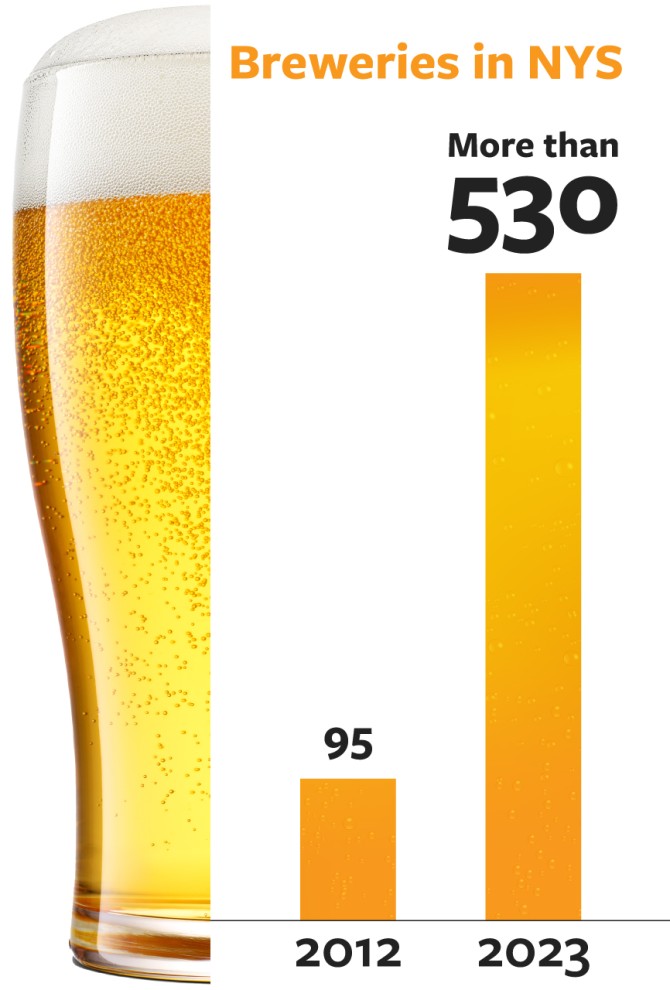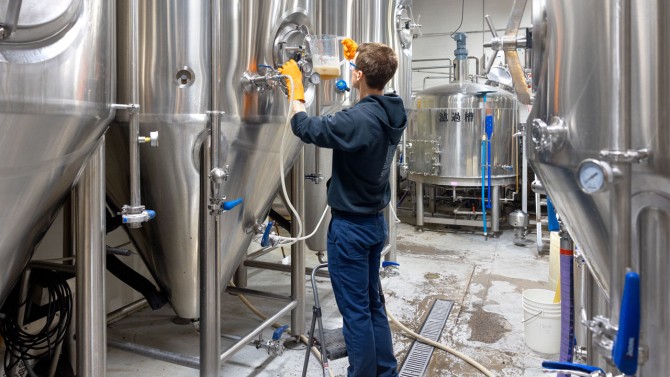
Jamey Tielens, left, and Ben Brotman consult on a recent brewing day at Liquid State Brewing Company. Brotman says the state’s brewers organizations “keep brewers in touch with other breweries and build a sense of camaraderie.”
As US craft beer industry goes flat, NYS bubbles with optimism
By Laura Reiley, Cornell Chronicle
After decades of growth, craft beer nationwide is in its worst-ever slump, with negative production for the second straight year and more craft brewery closures in 2023 than ever before. But the graph for New York state hasn’t wobbled, with 539 craft breweries and counting, ranking it second in the nation.
“We are holding steady,” said Paul Leone, executive director of the New York State Brewers Association. “It’s one of those states where some craft breweries are closing, some are opening, some are expanding and some are right-sizing. That leaves us flat – which is not a bad thing in this environment.”
The reasons for New York’s unique ability to weather the industry downturn are myriad, a combination of consumer enthusiasm, a tradition of cooperation and the right mix of savvy state policies and technological innovation. Cornell has recently doubled down on its commitment to craft beer research and industry support, for the first time adding an extension associate to focus on brewing with the Craft Beverage Institute.
This spring, Frank Addeo was brought on to play a lead role in coordinating brewing and distilling extension programs and workshops, and to add expertise in grain fermentations to the craft beverage institute team.
“I have talked with Frank a bunch,” said Ben Brotman, who with Jamey Tielens opened Liquid State Brewing Company in Ithaca seven years ago after meeting as colleagues at the Cornell Lab of Ornithology. “For a startup brewery it would be invaluable to have a resource like Frank, someone who has worked in the industry.”
Relocating from Washington state, Addeo says New York is second only to California in the total number of breweries.
“The New York state brewers’ guilds and regional group members are highly active, prioritizing collaboration and mutual support,” Addeo said. He also attributes some of the state’s success to consumers’ discerning tastes and desire for variety in their beverages, which diversifies product support.
Other industry experts agree.
“New York has a special affinity for our local foods and our craft beverages, both rooted in the state’s agricultural tradition,” said Julie Suarez, associate dean for land-grant affairs in the College of Agriculture and Life Sciences. “We’ve seen a wave of innovation sparked by many Cornell scientists and researchers, and the industry has benefited from our education and entrepreneurship training.”
Suarez says the unique aspect of Cornell CALS land-grant status is that faculty and extension staff have helped the industry grow through scientific innovation and education, oftentimes working with a farm for multiple generations.
“Cornell’s College of Agriculture and Life Sciences has been working with the local craft beverage industry since the 1970s – from new grape varietals like Cayuga White and Traminette to Cornell-bred Excelsior Gold malting barley and the Cornell Craft Beverage Analysis Lab,” she said.
Innovation in state policy has also proved an enduring catalyst, according to Suarez, who points to the success of the farm winery license, which led to the state allowing other craft beverage producers that use products grown in New York to operate similarly to farm wineries.
After Prohibition, a three-tier system developed for the sale of alcohol. There were manufacturers, distributors and retailers, but an entity couldn't be all three, said Derek Edinger ’94, M.S. ’95, brewer and co-owner of Brewery Ardennes Taproom and Kitchen in Geneva, New York. The farm brewery law essentially allows craft brewers to produce, distribute and sell their products.
“Craft beverage is a highly regulated industry that favors much larger breweries because of that three-tier system at the federal level,” he said. “The farm brewery law that went into effect in 2013 was a real game changer, leveling the playing field for smaller breweries to grow. That's a big differentiator in New York.”
The legislation allows farm brewers to open restaurants, conduct tastings of all farm-produced beverages, and allows them to open branch stores anywhere in the state. It also protected a tax benefit for small brewers. This supercharged growth in the state: The number of breweries increased from 95 in 2012 to more than 530 last year.
But there are other reasons New York has fared well, Edinger said.
“New York doesn’t really have one style that it’s known for,” he said. That means there are few limits to what can be made and what can find an audience, unlike other parts of the country where IPAs maintain something of a stranglehold.
“My brewery does Belgian-style beer. A lot of businesses know that they need a light lager on tap, and there are other styles that have a foothold here. For instance, because of Genesee Cream Ale brewed in Rochester, cream ale is a unique style that is becoming popular among consumers again,” Edinger said. “Go to the grocery store and it will make your head spin.”
The grocery store may hold another key to New York’s strong craft beer market, says Bradley Rickard, a professor of food and agricultural economics in the Charles H. Dyson School of Applied Economics and Management, part of the SC Johnson College of Business. New York is one of just a handful of states that allows only beer to be sold in grocery stores, gas stations and convenience stores. New bills propose selling wine in grocery stores, but wine and spirits retailers have argued this would be a death knell for many small, family-owned businesses.
This leaves lots of shelf space for craft beer, Rickard said. He said overall New York ranks 47th out of 50 states in per capita alcohol consumption, but that it’s a top 15 wine-consumption state, and wine drinkers are generally more inclined to drink craft beer, as opposed to mass-produced beer.
Larry Smart, a professor in the horticulture section of the School of Integrative Plant Science in Cornell CALS, has been working with the Hop Growers of New York to breed a high-yielding, disease-resistant and aromatic hop that performs well in New York state and can be marketed by brewers as New York’s hop. He says New York’s craft breweries generate nearly $4 billion in economic impact for the state, but that nearly all of the hops they use are bred and grown in the Pacific Northwest.
Nationally, hop production is down 15% to 20% this year due to declining beer sales, Smart said. He said he’s hopeful that some of the new hop varieties coming out of the USDA hops breeding program at Oregon State University would work in a New York climate.
“One of our goals at Cornell is to test those varieties and when we find some that are promising, to scale them up and get them into the hands of brewers,” Smart said. “We’re looking for that perfect match that is profitable for the grower but also has a market because brewers want to use it.”
He says that New York residents and tourists are enthusiastic locavores, often seeking out food and beverages that reflect regional supply chains, incentivizing brewers to source locally. Steuben Brewing in Hammondsport is a good example of this, he said, with a chalkboard in its taproom listing the local farms where they source their barley and hops.
For Douglass Miller, senior lecturer in the SC Johnson College, the final clue to the state’s craft beer robustness is a deep interconnectedness – with Cornell, but also with other parts of the food and beverage industry.
“I can name about eight Cornell alumni in the state’s craft beer industry,” he said. “But locavorism augurs for a strong and connected food and beverage landscape. We have the beer trail, the wine trail, the cheese trail – all these industries help support each other, help with a sense of storytelling and sense of place.”
Media Contact
Get Cornell news delivered right to your inbox.
Subscribe



